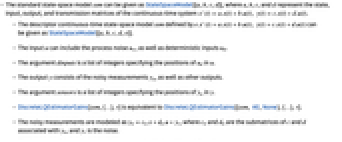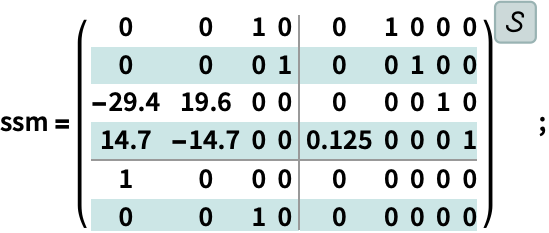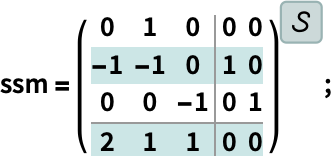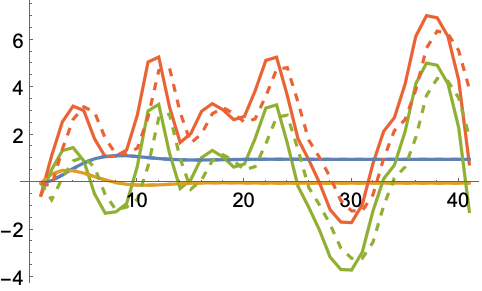DiscreteLQEstimatorGains
✖
DiscreteLQEstimatorGains
DiscreteLQEstimatorGains[ssm,{w,v},τ]
给出过程与测量噪声协方差矩阵为 w 和 v 的连续时间的 StateSpaceModel ssm 的优化离散时间估计器增益矩阵,其中采样周期为 τ.
DiscreteLQEstimatorGains[{ssm,sensors},{w,v},τ]
指定 sensors 作为 ssm 的测量噪声.
DiscreteLQEstimatorGains[{ssm,sensors,dinputs},{w,v},τ]
指定 dinputs 作为 ssm 的确定性输入.
更多信息和选项

- 标准状态-空间模型 ssm 可以是 StateSpaceModel[{a,b,c,d}],其中 a、b、c 和 d 代表连续时间系统
 的状态、输入、输出和传输矩阵.
的状态、输入、输出和传输矩阵. - 描述符连续时间状态空间模型 ssm 由
 定义,可以以 StateSpaceModel[{a,b,c,d,e}] 形式给出.
定义,可以以 StateSpaceModel[{a,b,c,d,e}] 形式给出. - 输入
 可以包括过程噪声
可以包括过程噪声  和确定性输入
和确定性输入  .
. - 参数 dinputs 是一个整数列表,指定
 在
在  中的位置.
中的位置. - 输出
 包括测量噪声
包括测量噪声  以及其它输出.
以及其它输出. - 参数 sensors 是一个整数列表,指定
 在
在  中的位置.
中的位置. - DiscreteLQEstimatorGains[ssm,{…},τ] 等同于 DiscreteLQEstimatorGains[{ssm, All,None},{…},τ].
- 测量噪声为
 ,其中
,其中  和
和  是与
是与  相关联的
相关联的  和
和  的子矩阵,
的子矩阵, 是噪声.
是噪声. - 过程和测量噪声假设为白噪声和高斯噪声:
-
 ,
, 
过程噪声  ,
, 
测量噪声 - 用具有优化增益的估计器最小化
 ,其中
,其中  是估计的状态向量.
是估计的状态向量. - DiscreteLQEstimatorGains 计算基于离散的等同的噪声矩阵上的估计器增益.
- 状态空间模型 ssm 使用零阶保持方法进行离散化处理.
范例
打开所有单元关闭所有单元基本范例 (1)常见实例总结
范围 (3)标准用法实例范围调查

https://wolfram.com/xid/0ejrq8bz9uwp102keduac-b0ghau

https://wolfram.com/xid/0ejrq8bz9uwp102keduac-nf6be

https://wolfram.com/xid/0ejrq8bz9uwp102keduac-3tucws

https://wolfram.com/xid/0ejrq8bz9uwp102keduac-el6ya

https://wolfram.com/xid/0ejrq8bz9uwp102keduac-6ko45l

https://wolfram.com/xid/0ejrq8bz9uwp102keduac-r1g9i
属性和关系 (1)函数的属性及与其他函数的关联
使用 DiscreteLQEstimatorGains 求估值器增益:

https://wolfram.com/xid/0ejrq8bz9uwp102keduac-i2y59e
https://wolfram.com/xid/0ejrq8bz9uwp102keduac-bn6wl
https://wolfram.com/xid/0ejrq8bz9uwp102keduac-h7hl39
https://wolfram.com/xid/0ejrq8bz9uwp102keduac-yhnf4p
https://wolfram.com/xid/0ejrq8bz9uwp102keduac-utllod
https://wolfram.com/xid/0ejrq8bz9uwp102keduac-r76zpx
https://wolfram.com/xid/0ejrq8bz9uwp102keduac-xnjvt9
https://wolfram.com/xid/0ejrq8bz9uwp102keduac-y2s8k9
https://wolfram.com/xid/0ejrq8bz9uwp102keduac-oo3p31
https://wolfram.com/xid/0ejrq8bz9uwp102keduac-80czbn

Wolfram Research (2010),DiscreteLQEstimatorGains,Wolfram 语言函数,https://reference.wolfram.com/language/ref/DiscreteLQEstimatorGains.html (更新于 2012 年).文本
Wolfram Research (2010),DiscreteLQEstimatorGains,Wolfram 语言函数,https://reference.wolfram.com/language/ref/DiscreteLQEstimatorGains.html (更新于 2012 年).
Wolfram Research (2010),DiscreteLQEstimatorGains,Wolfram 语言函数,https://reference.wolfram.com/language/ref/DiscreteLQEstimatorGains.html (更新于 2012 年).CMS
Wolfram 语言. 2010. "DiscreteLQEstimatorGains." Wolfram 语言与系统参考资料中心. Wolfram Research. 最新版本 2012. https://reference.wolfram.com/language/ref/DiscreteLQEstimatorGains.html.
Wolfram 语言. 2010. "DiscreteLQEstimatorGains." Wolfram 语言与系统参考资料中心. Wolfram Research. 最新版本 2012. https://reference.wolfram.com/language/ref/DiscreteLQEstimatorGains.html.APA
Wolfram 语言. (2010). DiscreteLQEstimatorGains. Wolfram 语言与系统参考资料中心. 追溯自 https://reference.wolfram.com/language/ref/DiscreteLQEstimatorGains.html 年
Wolfram 语言. (2010). DiscreteLQEstimatorGains. Wolfram 语言与系统参考资料中心. 追溯自 https://reference.wolfram.com/language/ref/DiscreteLQEstimatorGains.html 年BibTeX
@misc{reference.wolfram_2025_discretelqestimatorgains, author="Wolfram Research", title="{DiscreteLQEstimatorGains}", year="2012", howpublished="\url{https://reference.wolfram.com/language/ref/DiscreteLQEstimatorGains.html}", note=[Accessed: 14-March-2025
]}BibLaTeX
@online{reference.wolfram_2025_discretelqestimatorgains, organization={Wolfram Research}, title={DiscreteLQEstimatorGains}, year={2012}, url={https://reference.wolfram.com/language/ref/DiscreteLQEstimatorGains.html}, note=[Accessed: 14-March-2025
]}


